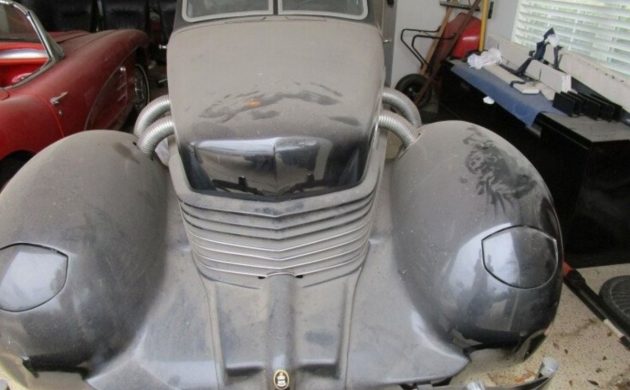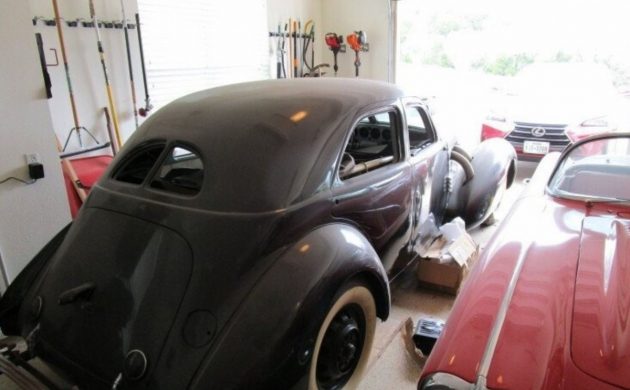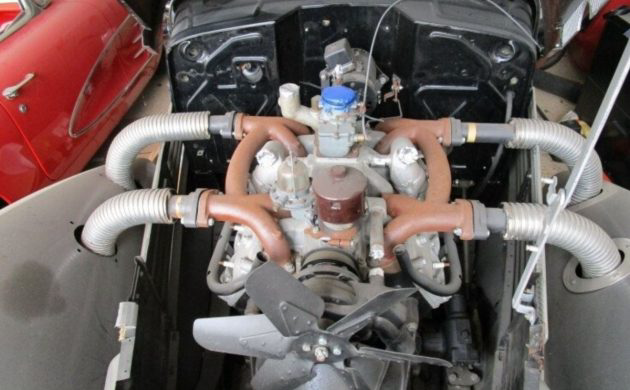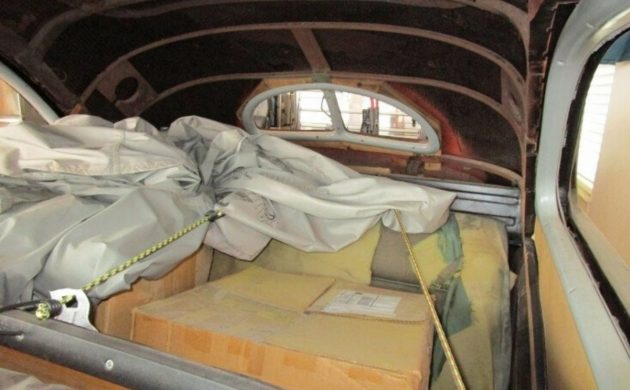When Cord unveiled its 810 model at the New York Auto Show in November of 1935, it caused a sensation. The company was inundated with orders and committed to commence deliveries by Christmas. In their defense, they didn’t specify which year that Christmas would fall, with the first production examples finding their way into buyer’s driveways in April of 1936. The model’s revolutionary drivetrain was plagued with early reliability issues, and when combined with the tardy delivery schedule, it did the brand’s reputation damage, from which it never recovered. Our feature car is a 1936 810 Westchester Sedan that appears to be a stalled restoration project. It is essentially complete but will require some work and reassembly. The relative rarity of the Cord 810 makes it a classic worthy of attention. If your heart yearns for a luxury vehicle, it probably deserves a closer look. Located in Leander, Texas, you will find the Cord listed for sale here on eBay. Bidding has hit $11,300, but this figure remains short of the reserve.
This Cord is a garage find that appears to be a stalled project. It seems that it has been sitting in its current dry location for years, which could be good news for potential buyers. Below that coating of dust is Black paint that looks like it is in relatively good condition. There are a few minor chips and marks, but no significant damage. Depending on the buyer’s requirements for this restoration, they may treat the car to a repaint. They might also opt to leave things untouched. Given the potential value of this classic, I suspect that they will follow the path of a cosmetic refresh. The panels show no evidence of significant dents or damage, and there is no visible rust. If the Cord has spent its life in Texas, it may be rust-free. Some external trim pieces have been restored, but some will require a trip to the platers. There are boxes of parts inside the vehicle, including glass and other exterior trim items. If the buyer chooses not to treat the car to a repaint, it seems that everything is there for them to simply reassemble this classic.
The 810’s drivetrain combination is what made it so revolutionary. Its engine bay is occupied by a 289ci Lycoming flathead V8 that produced 125hp. The power was fed from that V8 to the front wheels via a four-speed pre-selector automatic transmission. Combined with independent front suspension, it made the Cord 810 unique amongst American manufacturers. The company also offered a supercharged version of this V8, producing 170hp. The seller is a little bit vague about this classic’s mechanical health. He believes that both the engine and transmission have been rebuilt, but it seems that he has no evidence to verify this. The engine looks clean, but it isn’t clear whether it turns freely. Given the relative rarity of these motors, I would be treating it to a thorough inspection before attempting to coax it back to life. It is also worth noting that while it wears the distinctive exhaust for a supercharged model, this car is normally aspirated. Those beautiful pipes feed a shiny new exhaust, while the wide whitewall tires are also new.
Despite what the photos would tend to suggest, it seems that most of the major interior components remain intact. The dash, seat frames and padding, and door trims are present. However, the buyer will face the challenge of re-trimming this interior. I have performed a brief internet search but cannot locate interior trim kits for these cars. That is no great surprise, so the buyer will probably need to employ the services of an experienced upholsterer to return it to its former glory. From a positive perspective, Cord upholstered the interior of the 810 Westchester sedan in flat broadcloth. That means that the material for this interior will not break the bank. Once complete, the lack of a transmission tunnel and acres of interior space means that the occupants will be able to stretch out in total comfort.
When Cord unveiled the 810, their stated intention was to produce 1,000 cars per month. The reality was a long way short of that, and thanks to ongoing delays, the company delivered a mere 1,764 vehicles during 1936. That makes these cars a relative rarity, and their values tend to reflect this. Fully restored, our feature car should be capable of commanding a value over $60,000. However, if the new owner achieves perfection, it has the potential to nudge six-figure territory. Depending on where the seller has set his reserve, this project could make sound financial sense. It might be worth watching this auction closely.







Looks like the poor vette next to it took a hit to its right flanks.
These will always be drop dead gorgeous cars. I would have thought a pristine restoration would be north of $100.
I feel funny suggesting this since it’s a full CCCA classic. Figure out a way to modernize the front wheel drive and engine reliability, modern disc brakes, keep it black, tobacco colored leather and maybe custom rear fender skirts. I would drive it with pride!
Why would you cannibalize a real Cord when you can buy a fakey do one?
A Graham Hollywood would substitute.
Or a Hupp Skylark?
I have both a 36 Cord and a Hollywood here in Alaska. Cord is complete but not all together and Hollywood missing engine and transmission. Thinking of custom mods to it.
That front photo reminds me of Kardashians booty!
Only 320 ish Hupps made so not an easy one to find either, 1800 Grahams, but still less than the Cords.
This is still a preservation and restoration site, as exemplified by the Barn Finds logo: https://images.app.goo.gl/EM4moQaWagyxMMH48
Ron Jones Put the Hollywood on an Alston chassis with a 6.4 Hemi or a LS motor.
I have a 59 and 3, 60 T Birds. The wheel base is about identical. I’m a collector with about 50 cars, but running out of birthdays to get them all done, (72).
Some of these Cords had Citroen DS21 drivetrains swapped into them if they were minus the guts. And it was probably a Citroen Traction Avant which inspired the Cord drivetrain in the first place, as the 1935 Traction Avant was the first real volume FWD car – running from ’35 thru ’57 – and one managed to rack up 400,000 miles over some yrs – an early mileage record considering how early in auto history it took place.
I believe fewer than about 3000 Cords were built, so it’s a pretty rare beast. The front suspension is interesting in that the arms are tubular boomerangs, pivoted off the front end, but trailing back to the wheels, and operatiing a transverse leafspring at the front.
The gearbox is actually a manual one, but operated by a set of vacuum solenoids, each of which is triggered by a tiny gear selector on the column. Depressing the clutch actually closes a gearshift solenoid which connectds engine vacuum to slide a gear shifter fork in the transmission. Releasing the clutch reconnects the clutch to the transmission. So it’s a preselector semi-automatic. According to one owner, the car cruises nicely at 70-89 mph with the V8.
One of the most influential designs of all time. Need proof? Check out the 2023 Genesis G90, with its distinctive wraparound lighting interrupted by fully radiused wheel openings.
I’d love to go for this one, but it would probably pull a fair bit more if whoever is selling it had opened the boxes and documented all the parts in them – without that info it’s a bit of a grab bag mystery. I finally got a complete ’37 supercharged Beverly in 2019 out of a collection in Illinois – had been waiting since I was 16 to find one. The engineering is fascinating in addition to the very distinctive incomparable styling – nothing else like them!
The front suspension is really interesting as each arm is mounted to the chassis on rollerbearings, which should give extreme accuracy to the steering versus rubber bushings, which nearly every other car in the world uses, and they can flex sideways, harden, crack and wear out – not so with good sealed bearings – theyre as rigid laterally as a metal lathe headstock.and allow more vertical travel than rubber bushigs.
At the asking price, this is a PERFECT entry level classic to get into as a father-son project. Who knows was jewels lie inside those cardboard boxes on the seats. Given the right circumstances, one could drive the car while restoring. Who would choose the perforated Amphicar over this wonderful piece of automotive art?
These Cords are a thing of dreams for any car enthusiast. It would take a knowledgeable restorer to tackle the reassembly of this baby. The glass, trim and interior alone will be daunting. Hopefully the drivetrain was rebuilt earlier and with a car like this it would demand a thorough inspection and some homework. Great find